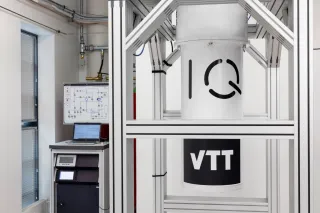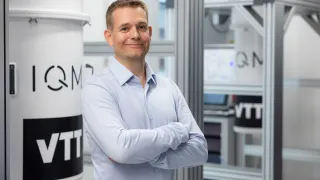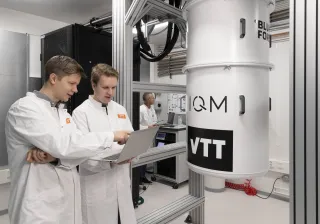The era of targeted benefits in quantum computing lies within a 3–5-year time horizon. A quantum computer will then compute a particular useful problem better than a classical computer. Companies and industry should consider how the coming era could benefit their own business. There is still some time to create your own strategy.
Quantum computing is the subject of intense research and debate. Businesses are feverishly considering whether to react and opinions are divided. Some are waiting to see the first breakthroughs, others have already set up quantum computing teams to practise applying it to their own industry. Are the pioneers wasting their resources or should even sceptical companies join the experimenters? The hype generated by the lively debate can prevent people from seeing the true nature of the technology and make decision-making more difficult. Expecting too much can lead to disappointment, while ignoring the progress can be risky and give competitors too much of a head start.
One topic of discussion is the number of qubits. There is a wide range of figures, which makes it difficult to understand the subject. Canadian quantum computing company D-Wave offers 5,000 qubits, IBM has announced 1,000 qubits, Quantinuum from the US and UK has 32 qubits and VTT is building 50 qubits. Does the superiority of the machines depend on the number of qubits?
Another confounder of the debate is quantum computing algorithms whose computational power has been theoretically proven, but whose usefulness awaits the era of error-corrected quantum computing. At present, there are still errors in quantum computing due to the sensitivity of qubits, which can lead to erroneous computational results. Algorithms can be run on today's machines, but only for problems so small and with such poor accuracy that experimenters may lose interest from the start.
The era of practice
In an ideal quantum computer, the number of simultaneous states increases exponentially as the number of qubits increases. Already at 50 qubits, the memory capacity of supercomputers is approaching its limits, as a 50-qubit quantum computer computes at 250 or 1015 complex numbers. So why doesn't IBM's 1,000-qubit machine already outperform all other quantum computers and supercomputers in the world? The number of qubits does not tell the whole story as the quality of the qubits, their interconnectivity and the amount of noise are also essential factors.
Today's quantum computers are noisy, and the qubits are only finitely coupled, so they do not match the computing power of a theoretical quantum computer – not even close, even with 1,000 qubits. We are now living in an era of quantum computing practice, and the whole world is practising to build, use and apply quantum computers.
Towards targeted benefits
The quality of qubits is called fidelity, which tells you the probability of whether one operation on a qubit will succeed without error. As fidelity improves, it will be possible to perform more and more operations in sequence with a reasonable success rate and the quantum computer will be able to solve increasingly complex problems.
Current fidelity enables 2,000–3,000 operations between two qubits. This number can be used to solve targeted problems that fit the architecture of the quantum computer's inter-qubit coupling. These include simulations of certain quantum phenomena. The quality and speed of the solution approaches that of a calculation using classical methods.
Fidelities have improved even faster than predicted. It is therefore expected that, within a timeframe of about 3–5 years, we will have machines with fidelities to run 10,000 two-qubit operations. In this case, a quantum computer will be able to compute a problem faster, in a more environmentally friendly way or with better quality than the best classical algorithm on a supercomputer. We are entering an era of targeted benefits. The benefit is not a general computing advantage, but will revolutionise the world by showing that a quantum computer can compute a useful problem more efficiently than a classical computer.
Business and industry should start exploring the potential of targeted benefits now, so that they can be harnessed as soon as possible. The advantage should not be given to competitors that may already be investigating their own problems.

Now is the time to explore the benefits of quantum computing
This improvement in fidelity will eventually enable error-corrected quantum computing, which will affect all industries. Several noisy qubits together can form a single computational qubit, and errors in noisy qubits can be detected and corrected by other qubits. This will further improve the fidelity of this computational higher-order qubit.
When we have hundreds of thousands or millions of sufficiently high-quality noisy qubits, we can form hundreds or thousands of sufficiently high-quality error-corrected qubits from them. Error-corrected qubits make it possible to run quantum algorithms with a theoretically proven advantage over classical computing. Then it's just up to the algorithm and the problem how many error-corrected qubits are needed to gain an advantage.
The era of error-corrected quantum computing is 10–15 years away. Although this is still a long way off, it is important for companies to start exploring their own computational cases now and to identify which problems are suitable for error-corrected quantum computing and which are not. Understanding and learning take time.
There is still time to practise quantum computing and improve your own quantum computing strategy. The era of targeted benefits will dawn in the coming years. Not all businesses and sectors can benefit from it, but for some it can be a lifeline. The open question is who will benefit who will not. The only way to find out is to jump in and explore.
Prepare for the Quantum Era with VTT
Ready to take the next step? Discover how VTT's Quantum Computing services can future-proof your business. Dive into cutting-edge solutions and stay ahead of the curve.
Explore now





